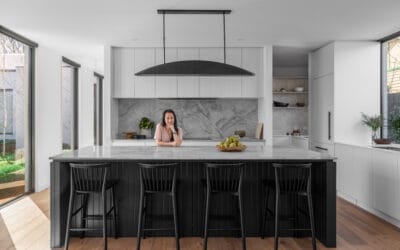Have you been dreaming about flippling houses after watching some of those TV shows? Do you think that it might be a fun way to make some money? Perhaps an opportunity to flex your creative skills too?
This is great news! In this article, we will look to give an overview of house flipping and some of the key considerations.
Flipping a house generally refers to purchasing a property, making renovations/additions/alterations, and then selling it for a higher price (well, the higher price is the game, however, not everyone gets there!).
There is potential to make a ‘quick’ profit but to make sure you get to the point of profit, there will be a number of tangible and intangible considerations and value judgements to make first.
This blog post will give you:
- an introduction to the process of flipping houses
- the costs involved
- considerations that will inform your purchase and pathway forward
So, without further ado, let’s get started!
INDEX
What Is House Flipping?
The Cost of Flipping a House
Other Important Considerations When Flipping Properties
So Is House Flipping Right for You?
What Is House Flipping?
This refers to the process of purchasing a property, renovating it, and then selling it for a higher price. The goal is to turn a considerable profit on the sale after accounting for all of the costs associated with buying and improving the property.
Simple – right?
The Process of Flipping a House
Once you have financing in place, it’s time to start thinking about the process of flipping a house. There are four main steps involved in flipping a house:
Step 1. Finding properties
Finding the right property to renovate and add value is your first big step. It is important to understand the value that your renovation will create and that purchasers will pay for the work you have completed.
You can find properties in the more traditional ways, such as looking online at listing sites, contacting owners directly, working with a buyers advocate or working directly with a reals estate agent in the area you are searching.
It is important to understand the market, and how properties are sold, too. Often, many off-market sales are not listed publically, and these can be a great way to secure the perfect project.
Step 2. Understand the Value Proposition and secure the property
Run your numbers!
You will want to get really fast at knowing what you will do to a home to add value, how you will undertake the work, so you know the costs associated and the working this through on your feasibility to understand how much this home is worth for you and what your potential for profit will be.
When purchasing a project, ensure your numbers are not too optimistic, you have room to move and a contingency for unforeseen costs!
Step 3. Renovating the property
Once your offer is accepted, and you have negotiated the terms of your agreement, then you will be able to start finalising your design and get renovating!
You should have decided before you purchased the property what works, cosmetic or extensive, will be required to turn a profit. Now is the time to get whatever permits you need and start working through your plan.
It is important to stick to your budget and schedule, understanding what will bring you a return on your investment! The game is ‘renovating for profit’, so ensuring every decision is a value-based decision will allow this to happen. A detailed and realistic scope of work and budget will allow you to complete the renovation on time and under budget.
Unrealistic expectations and lack of methodical planning can lead to a disastrous situation where the timeframes spiral along with the budget, and this can eat into your anticipated profits quickly!
Step 4. Selling the property
Once your renovation is complete, it’s time to test the market and list the property for sale! Make sure you have budgeted the right amount to see this process through to completion and maximise your return.
How you sell and the costs involved will be area dependent! Some areas need you to dress the home with staging furniture, some an auction process will be best, whereas others might be sold at an asking price or expressions of interest.
Only when the home is sold will you be able to calculate your true costs and profits! Test the assumptions you put into your feasibility calculator. You can use our template as a guide!

The Cost of Flipping a House
Whilst renovating for profit and ‘flipping properties’ can be a very lucrative business, but it’s not without its risks.
One of the biggest risks is that you may end up spending more money on repairs and renovations than you anticipated. You must have a realistic idea of the amount of work that needs to be done before you purchase a property to ensure you’re not biting off more than you can chew.
In order to make a profit from flipping a house, you need to be able to sell it for more than the purchase price, plus the cost of any renovations.
There are a few things that will affect the cost of renovations, including:
- The scope of the renovations: Are you doing major updates to some areas of the property, or are you gutting the property and starting from scratch?
- The location of the property: Properties in desirable locations can often demand a higher level of finishes and cost more to renovate than properties in less desirable areas.
- The current market conditions: If materials and labour are in high demand, renovating a property will usually cost more. Like many others, the construction industry has a fluctuating workflow. It has seasons of peaks and troughs, which can correlate to the cost of work.
Many expenses are involved in flipping a house – some of which can be unforeseen and only known when you start pulling apart walls. If you are not careful and haven’t budgeted correctly, allowing for contingencies, these costs can eat into your profits—or even put you in the red.
Here are some of the common expenses associated with flipping houses so that you can be better prepared when taking on your next project.
The Purchase Price
The most obvious cost associated with flipping a house is the property purchase price.
The purchase price will depend on factors like location, property condition, and real estate market trends. Some say that buying undervalue is the key to making a profit – we, however, know that buying well is essential but rarely is someone going to let their home go significantly under value.
So to create a sustainable business and game plan for renovating, you will need to buy well but at market rates, and increase the home’s value by way of your renovation/extension and improvements.
Renovation Costs
There will be two categories of renovation, ones that are structural and unseen but need to be completed (such as reblocking) and renovations/extensions, which increase the home cosmetically and hopefully also improve the flow and livability.
Beware of homes that require a large amount of investment that will not be seen by the purchasers, as it can prove difficult to get a return on these works.
The work you complete on a project should be tailored to get the maximum return on investment. There are often many different ways you could improve projects – which have different implications on the size and scale of the works.
At BuildHer Collective, we do not subscribe to rules which blanket say you must do this, or you must do that – here are some examples:
- It is preferable to keep as many of the existing walls where they are currently located, and not move the plumbing fixtures too far from their original location.
- However, if the flow of the home is significantly impacted by bathrooms in strange or unusual locations, then moving this to another location may actually give you a great return on investment!
If you are going to ‘flip properties’ or make a large investment in renovating your home – then you need to understand the cost of the renovations and the value that this scope will bring to the home. After all, it is only when the total of the costs, of which renovation is a large percentage and is less than the sale price, that you will actually be renovating for profit!
Financing Costs
If you’re taking out a loan to finance your flip, then you’ll also need to factor in financing costs. These include interest payments on your investment property loan, origination fees, and closing/settlement costs. All these need to be factored into your calculations when coming up with your expected return on investment (ROI).
Holding Costs
Once you’ve purchased a property, you’ll need to pay for what’s known as “holding costs” until the property is sold. These include things like insurance, property taxes, and utility bills.
If the property is vacant during this time (which is often the case), then you may also need to factor in things like garden maintenance.
Selling Costs
When it comes time to sell the property, there are a number of associated selling costs that you’ll need to pay out as well. These include things like real estate commissions (if you’re working with an agent), transfer taxes, and can include marketing and property styling also.
If you are looking a renovating for profit – you will want to keep a clear understanding of the costs associated with the build. We created the project profitability calculator or feasibility template, so you might be able to use it as a checklist, assessing and entering costs against each line item.
Yes, the first step to looking at a project is a back-of-envelope calculation when you look at the basic numbers. Still, before you decide to proceed, you really need to start to quantify these numbers and account for all the little items that can add up to a significant expense.
Other Important Considerations When Flipping Properties
Here are things you need to keep in mind when thinking about flipping a house.
The Real Estate Market
Keep an eye on the property market as a whole.
If the market is on an upward trend, that’s generally a good sign for house flippers. However, if the value of the home increases over time, this doesn’t make your flip necessarily successful, as the next project you buy in that market will also have increased. The key here is to create value with the work you are doing and that you can control, so you do not depend on factors that no one can accurately predict.
If the market is on a downward trend, this could mean it is a harder market, or you can buy a project to renovate at much better prices. You will need to assess again the conditions that are causing market shifts, how your planned works will affect the project’s viability and look at what tolerances you can factor in as a bidder.
Pay attention to the real estate market news and trends so you can make informed decisions about when to buy and sell properties.
Timeline
Another important consideration is your timeline for flipping the property.
The amount of time it takes to renovate and flip property will vary depending on the scope of work required, permits and other factors. Be sure to have a realistic schedule, as time and cost go hand in hand!
When renovating for profit, it is important to ensure that you understand all the steps involved in flipping a house before making an offer on a property. Organisation and speed in completing work are a must to maximise your profitability.
Competition
Competition in the flipping market is higher than it has been in recent years. This means that you need to be smart and strategic about your property investment decisions if you want to succeed.
Focus on properties in high-demand areas or that have unique features that will appeal to buyers. The value you see in a project is important – what potential can you see that others can’t?
It’s also important that you have a clear understanding of your target market and what they’re looking for in a flipped house. By doing your homework and really getting to know your target market, you’ll be in a better position to find properties that are sure to sell quickly and for top dollar.
Your skills and experience
Last but not least, you need to be honest with yourself about your own skills and experience.
Do you have experience with construction or home renovations? If not, are you willing to learn? Do you have the time and energy to take on a project like this?
It’s important to be realistic about what you can handle before taking on a flip. And if you’re interested in improving your house flipping knowledge and skill, sign up for related courses.
Plenty of courses are available to teach you everything from the basics of real estate investing to more advanced topics such as construction and design.
The advantages of taking courses, such as our “DevelopHer’s Masterclass”, before a house flip will include:
- Learn about different aspects of house flipping: There is much more to flipping houses than just finding a good deal on a property. When you take courses, you will learn about the different aspects of flipping houses. And this will give you a better idea of what is involved in the process and avoid any pitfalls along the way.
- Gain confidence: If you feel like you are well-prepared and have all the necessary knowledge, you are more likely to approach your first flip with confidence. This can make all the difference in whether or not your flip is successful.
- Meet other like-minded people: When you take any of our offered courses on flipping houses, you will also meet other people who are interested in the same thing as you. This can be a great way to network and form relationships with people who can help you with your future flips.
Today, purchasers have access to so much more information than ever; their expectations are changing, and they require a different product. You can no longer quickly tart up a house in 6 weeks and pop it back on the market to expect supercharged success.
You need to be targeted with the value you bring and realistic about the process! There is still much money to be made and a huge amount of fun in making it!

So Is House Flipping Right for You?
That depends. If you’re thinking about flipping a property, there are several things you need to keep in mind.
To help ensure that you’ll make the right investment decision, make sure you are using a feasibility template.
A feasibility template is simply a document that helps you figure out the cost of the project, potential risks, and other factors that could impact your investment. This information is essential for making an informed decision about whether or not to proceed with the project.
You will also need to understand the scope, delivery, financing, taxation implications, sale methods, and so much more. But a robust feasibility should give you the confidence to tackle that project with confidence.
Conclusion
House flipping can be a great way to build capital, but it’s not without its risks.
Make sure you understand the realistic costs and risks of a project before getting started. Take advantage of valuable tools and resources, including a feasibility template and when investing this amount of money, ensure you learn the process and how to maximise your outcomes!
At BuildHer Collective, we created a program to show you this pathway as we found people either didn’t understand the entire process or left money on the table in certain areas. Flipping and renovating for profit is an amazing and fun way to live and make a living, and with a little knowledge and a great process, you can minimise your risk, maximise your profits and, importantly, enhance your lifestyle.







